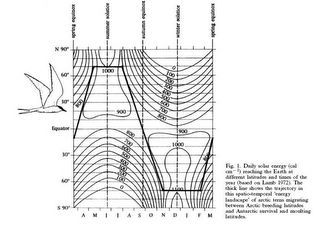A few important facts concerning the long-distance migrating
Wednesday, April 13, 2005
1. The genetic constitution of various “adaptional traits” are probably based on the regulation of characters existing (but dormant) also among residents, so that migration behavior is only an extension of general seasonal adaptations in mouvement, homing, metabolism etc, rather than constituting an altogether separate quality.
2. The average annual survival rate of adult arctic terns is almost observed at 90%: no lower than the other stern species, a fact indicating that long-distance migration does not appear to increase the difficulty of evolution theory as much as we are inclined to believe from a first hearing.
3. If by absolute distance arctic tern win the championship of all migrating species, by combining the body length (a very considerable energy factor), it is not even among the first three, see the table below:
no/Species/Distance(km)/Body length(m)/Effort(distance/body length)
1/Willow warbler/15500/0.11/141000
2/blackpoll warbler/12000/0.14/86000
3/pectoral sandpiper /16500/0.21/79000
4/Swift/11500/0.17/68000
5/American golden plover/15500/0.26/60000
6/Red phalarope/12500/0.21/60000
7/Arctic tern/19000/0.35/54000
And that is only for birds. If we include in our competition also insects, there will be two more strong competitors:
3/Desert locusts/5000/0.06/83000
5/Monarch Butterfly/3600/0.05/72000
4. In terms of exploiting seasonal resource, notably solar energy, the trajectory of arctic tern shows an astonishing “understanding” of earth’s spatio-temporal energy landscape.

to be continued
2. The average annual survival rate of adult arctic terns is almost observed at 90%: no lower than the other stern species, a fact indicating that long-distance migration does not appear to increase the difficulty of evolution theory as much as we are inclined to believe from a first hearing.
3. If by absolute distance arctic tern win the championship of all migrating species, by combining the body length (a very considerable energy factor), it is not even among the first three, see the table below:
no/Species/Distance(km)/Body length(m)/Effort(distance/body length)
1/Willow warbler/15500/0.11/141000
2/blackpoll warbler/12000/0.14/86000
3/pectoral sandpiper /16500/0.21/79000
4/Swift/11500/0.17/68000
5/American golden plover/15500/0.26/60000
6/Red phalarope/12500/0.21/60000
7/Arctic tern/19000/0.35/54000
And that is only for birds. If we include in our competition also insects, there will be two more strong competitors:
3/Desert locusts/5000/0.06/83000
5/Monarch Butterfly/3600/0.05/72000
4. In terms of exploiting seasonal resource, notably solar energy, the trajectory of arctic tern shows an astonishing “understanding” of earth’s spatio-temporal energy landscape.

to be continued
edit


No comments:
Post a Comment